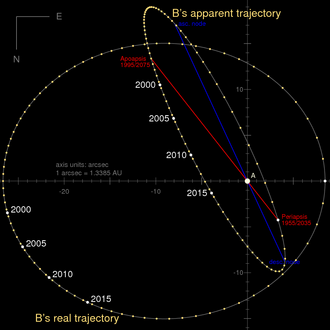Stellar system

Alpha Centauri is a triple star system, with its two main stars, Alpha Centauri A and Alpha Centauri B, being a binary component. The AB designation, or older A×B, denotes the mass centre of a main binary system relative to companion star(s) in a multiple star system. AB-C refers to the component of Proxima Centauri in relation to the central binary, being the distance between the centre of mass and the outlying companion. Because the distance between Proxima (C) and either of Alpha Centauri A or B is similar, the AB binary system is sometimes treated as a single gravitational object.
Orbital propertiesedit
The A and B components of Alpha Centauri have an orbital period of 79.91 years. Their orbit is moderately eccentric, e = 0.5179; their closest approach or periastron is 11.2 AU (1.68 billion km), or about the distance between the Sun and Saturn; and their furthest separation or apastron is 35.6 AU (5.33 billion km), about the distance between the Sun and Pluto. The most recent periastron was in August 1955 and the next will occur in May 2035; the most recent apastron was in May 1995 and will next occur in 2075.
Viewed from Earth, the apparent orbit of A and B means that their separation and position angle (PA) are in continuous change throughout their projected orbit. Observed stellar positions in 2019 are separated by 4.92 arcsec through the PA of 337.1°, increasing to 5.49 arcsec through 345.3° in 2020. The closest recent approach was in February 2016, at 4.0 arcsec through the PA of 300°. The observed maximum separation of these stars is about 22 arcsec, while the minimum distance is 1.7 arcsec. The widest separation occurred during February 1976, and the next will be in January 2056.
Alpha Centauri C is about 13,000 AU away from Alpha Centauri AB. This is equivalent to 0.21 ly or 1.9 trillion km—about 5% the distance between Alpha Centauri AB and the Sun. Until 2017, measurements of its small speed and its trajectory were of too little accuracy and duration in years to determine whether it is bound to Alpha Centauri AB or unrelated.
Radial velocity measurements made in 2017 were precise enough to show that Proxima Centauri and Alpha Centauri AB are gravitationally bound. The orbital period of Proxima Centauri is approximately 547000+6600
−4000 years, with an eccentricity of 0.50 ± 0.08, much more eccentric than Mercury's. Proxima Centauri comes within 4300+1100
−900 AU of AB at periastron, and its apastron occurs at 13000+300
−100 AU.
Physical propertiesedit
Asteroseismic studies, chromospheric activity, and stellar rotation (gyrochronology) are all consistent with the Alpha Centauri system being similar in age to, or slightly older than, the Sun. Asteroseismic analyses that incorporate tight observational constraints on the stellar parameters for the Alpha Centauri stars have yielded age estimates of 4.85±0.5 Gyr, 5.0±0.5 Gyr, 5.2 ± 1.9 Gyr, 6.4 Gyr, and 6.52±0.3 Gyr. Age estimates for the stars based on chromospheric activity (Calcium H & K emission) yield 4.4 ± 2.1 Gyr, whereas gyrochronology yields 5.0±0.3 Gyr. Stellar evolution theory implies both stars are slightly older than the Sun at 5 to 6 billion years, as derived by their mass and spectral characteristics.
From the orbital elements, the total mass of Alpha Centauri AB is about 2.0 M☉note —or twice that of the Sun. The average individual stellar masses are 1.09 M☉ and 0.90 M☉, respectively, though slightly higher masses have been quoted in recent years, such as 1.14 M☉ and 0.92 M☉, or totalling 2.06 M☉. Alpha Centauri A and B have absolute magnitudes of +4.38 and +5.71, respectively.
Alpha Centauri Aedit
Alpha Centauri A, also known as Rigil Kentaurus, is the principal member, or primary, of the binary system. It is a solar-like main-sequence star with a similar yellowish colour, whose stellar classification is spectral type G2 V; it is slightly larger and more luminous than the Sun. Alpha Centauri A is about 10 percent more massive than the Sun, with a radius about 22 percent larger. When considered among the individual brightest stars in the sky (excluding the Sun), it is the fourth brightest at an apparent magnitude of −0.01, being slightly fainter than Arcturus at an apparent magnitude of −0.05.
The type of magnetic activity on Alpha Centauri A is comparable to that of the Sun, showing coronal variability due to star spots, as modulated by the rotation of the star. However, since 2005 the activity level has fallen into a deep minimum that might be similar to the Sun's historical Maunder Minimum. Alternatively, it may have a very long stellar activity cycle and is slowly recovering from a minimum phase.
Alpha Centauri Bedit
Alpha Centauri B, also known as Toliman, is the secondary star of the binary system. It is a main-sequence star of spectral type K1 V, making it more an orange colour than Alpha Centauri A; it has around 90 percent the mass of the Sun and a 14 percent smaller diameter. Although it has a lower luminosity than A, Alpha Centauri B emits more energy in the X-ray band. Its light curve varies on a short time scale, and there has been at least one observed flare. It is more magnetically active than Alpha Centauri A, showing a cycle of 8.2±0.2 yr compared to 11 years for the Sun, and about half the minimum-to-peak variation in coronal luminosity of the Sun. Alpha Centauri B has an apparent magnitude of +1.35, slightly dimmer than Mimosa.
Alpha Centauri C (Proxima Centauri)edit
Alpha Centauri C, better known as Proxima Centauri, is a small main-sequence red dwarf of spectral class M6 Ve. It has an absolute magnitude of +15.60, over 20,000 times fainter than the Sun. Its mass is calculated to be 0.1221 M☉. It is the closest star to the Sun but is too faint to be visible to the naked eye.
Comments
Post a Comment